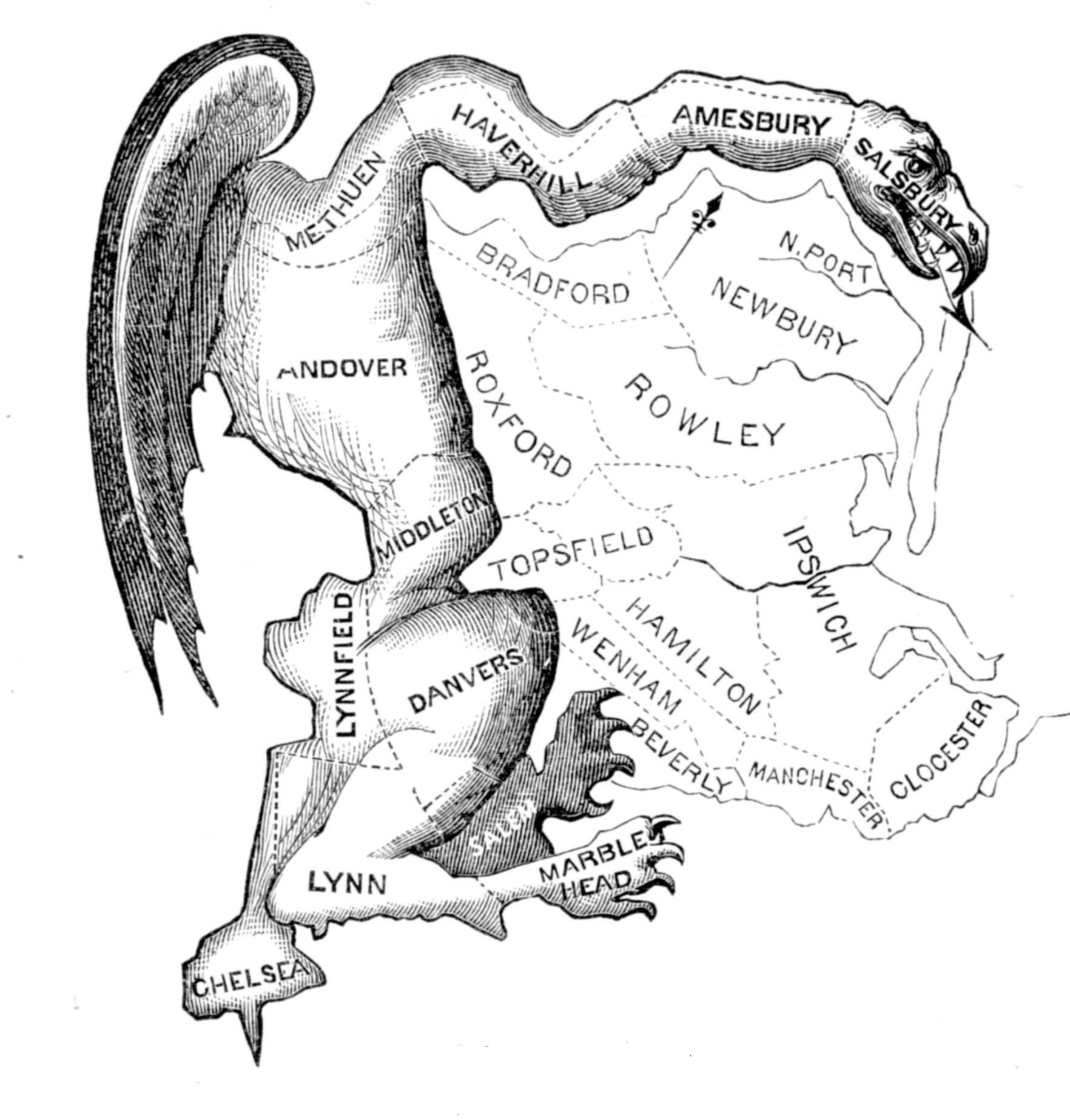Learning Objectives
After reading this section, you should be able to answer the following questions:
- What are the differences between House and Senate elections?
- What is the significance of midterm elections?
- What is gerrymandering, and how can it influence the outcomes of campaigns?
- Why only two Parties?
This section covers campaign organization, funding, and strategy. Getting elected often requires defeating opponents from the same political party in a primary election in order to become that party’s nominee. One party’s nominee must defeat the candidates from other parties in the general election. Election campaigns require organization, funding, and strategy. Legal guidelines, especially for campaign finance, influence the environment within which elections take place.
Congressional Elections
Congressional elections, in which all 435 House seats and one-third of Senate seats are contested, take place every two years, including years when there is a presidential election. Midterm elections occur in years when there is no presidential contest. Frequently, midterm elections are treated as referenda on the performance of the sitting president and can determine the balance of power in Congress. National issues, such as the economy and unemployment, can become prominent factors in midterm campaigns.
Since 1926, the president’s party has lost an average of thirty seats in the House and four seats in the Senate during midterm elections. The 2010 midterm election resulted in a sixty-three-seat swing and a shift in power in the House of Representatives. The Democrats lost control, as their membership dropped from 256 to 193 members, and the Republicans gained the majority, moving from 179 to 242 members. The Democrats, with fifty-three seats, maintained control of the Senate, although they lost six seats to the Republicans, who have forty-six seats. One seat is held by an Independent.[1]
Maps depicting congressional election results from 2016 and earlier can be found at 270 to win, and New York Times

Rand Paul at His Victory Celebration in 2010. Republican Rand Paul, an ophthalmologist, won the Senate race in Kentucky against Democrat Jack Conway, the state’s attorney general, with the backing of the Tea Party.
Local and regional media are in the best position to cover congressional elections, and they can set the agenda for national media. Typically, there is less media coverage of midterm elections compared with presidential campaigns. The 2010 midterm election received more coverage than usual, as voters expressed frustration with incumbent president Barack Obama’s performance in office. The Tea Party—a grassroots, conservative-leaning movement (not a political party) that opposed the government’s taxing and spending policies—staged protests that brought media attention to the election. Some Tea Party–backed candidates garnered significant national press attention.
The Senate
There are one hundred senators in the U.S. Congress, two elected from each state, who serve six-year terms. One-third of Senate seats are up for election every two years. Senators are constitutionally required to be at least thirty years old and to have been a U.S. citizen for at least nine years when they take office.
Many Senate elections are competitive in both the primary and the general election. Having been in office for six or more years, incumbents have records, controversial votes, and may have upset some of their constituents. Their opponents may have name recognition, ample funding, and run an effective campaign using the new media and political advertising. Especially when the election is close, challengers receive almost as much visibility as incumbents. They are able to publicize their images, get some of their issues on the campaign agenda, and have attention paid to their attacks on their opponent.
Senate races in the 2016 midterm election were hotly contested. The majority of incumbents won, but many faced tough competition. Twelve Democratic incumbents ran for reelection and three lost, while all twenty-two Republican incumbents seeking reelection won. Candidates spent record amounts of money contesting in Senate campaigns. Sharron Angle, who won the Nevada Republican Senate nomination with the backing of the grassroots Tea Party movement, spent ninety-seven dollars per vote in the general election, which she lost to Democrat Harry Reid, the majority leader of the Senate, who spent sixty-nine dollars per vote.[2]
The House of Representatives
There are 435 voting members of the House of Representatives elected in separate districts within states for two-year terms. Candidates must be at least twenty-five years old and need to have been a citizen for at least seven years.
Members of the House who are seeking reelection in districts designed to favor their party have an advantage. They usually have better organized campaigns, greater name recognition, far more funds, and more support from interest groups than their opponents. Since 1954, 93 percent of House incumbents have been elected. This rate dropped slightly in 2010, as 87 percent of incumbents were reelected, which is the lowest percentage since 1964.[3]
The media contribute to this incumbency advantage. Challengers often lack the funds to air political ads. News coverage of House elections favors incumbents. Local television coverage pays little attention to even to the most competitive House elections.[4] Indeed, four thousand local television newscasts, in eleven major markets during the four weeks before the 2004 election, gave eight times as much air time to car crashes and other accidents than to House campaigns.[5] The use of social media, such as Facebook and Twitter, can benefit challengers, especially if their messages are picked up by the mainstream press. However, many voters get most of the campaign information from television. Debates can sometimes improve a challenger’s chances if they are televised and widely seen. But nearly 70 percent of debates held by House candidates are not televised.Committee for the Study of the American Electorate, press release, May 16, 2001.
Be sure to click on the link below as there will be exam questions from it
Redistricting
Each state is awarded a number of seats in the House of Representatives based on its population as determined by the national census, which is taken every ten years as required by the Constitution. If the census reveals shifts in the size of the population within districts, state legislators redraw the district lines to equalize the number of people within each district.

Gerrymander (Gerry-Mander). In 1812, Massachusetts governor Elbridge Gerry pushed through electoral redistricting that ensured his Republican party’s majority in the township of Marblehead would outweigh the Federal majority in eleven other townships. Artist Elkanah Tisdale drew a cartoon map of the salamander-shaped district for the Boston Gazette and coined the term “Gerry-mander” (now “gerrymander”) that became a staple of political language. The visual and the term are therefore both media creations.
Redistricting is often a highly partisan and contentious activity because it can change the number of House seats each party wins in a state. The party in control of the state legislature can design districts so as to protect its incumbents and increase its House seats. The party in power can obtain more seats by having small but usually safe majorities in several districts and cramming large numbers of the other party’s voters into just a few districts. This is achieved through a gerrymander, drawing congressional district lines to give one party the advantage in electing its candidates to the House of Representatives. Make sure to click on gerrymander and watch the video for potential exam questions. [6] Incumbents in gerrymandered districts are usually reelected.
Key Takeaways
Elections are crucial in a representative democracy like the United States. They enable people to choose their leaders and thereby influence public policy. They endow elected officials with legitimacy. There are two main types of elections: primary and general elections. Candidates from the same political party contest for the party’s nomination in primary elections. Candidates from different parties run in the general election, which decides who will take office.
Campaign finance is an integral element of American elections. Individuals, PACs, public funds, political parties, candidates themselves, and 527 committees fund campaigns. Campaign finance laws have shaped the way that candidates raise and spend money in elections, especially presidential candidates who accept public funding.
Candela Citations
- 21st Century American Government. Authored by: Anonymous. Provided by: Lardbucket. Located at: http://2012books.lardbucket.org/books/21st-century-american-government-and-politics/s15-01-election-campaigns.html. License: CC BY-NC-SA: Attribution-NonCommercial-ShareAlike
- Voter poll. Authored by: RadioFan. Located at: https://en.wikipedia.org/wiki/File:Voter_poll.jpg. License: CC BY-SA: Attribution-ShareAlike
- Sarah Palin and John McCain. Authored by: Matthew Reichbach. Located at: https://commons.wikimedia.org/wiki/File:Sarah_Palin_and_John_McCain_in_Albuquerque.jpg. License: CC BY: Attribution
- Barack Obama. Authored by: Bbsrock. Located at: https://commons.wikimedia.org/wiki/File:ObamaAbingtonPA.JPG. License: CC BY: Attribution
- Hillary: The Movie Trailer. Provided by: Citizens United. Located at: https://youtu.be/BOYcM1z5fTs. License: All Rights Reserved. License Terms: Standard YouTube license
- Bob Dole, 60th Anniversary VE Day. Authored by: Samantha Quigley. Provided by: U.S. Department of Defense. Located at: https://commons.wikimedia.org/wiki/File:Bob_Dole_VE_Day_60th_Anniversary.jpg. License: Public Domain: No Known Copyright
- George W. Bush. Authored by: Eric Draper. Located at: http://commons.wikimedia.org/wiki/File:George-W-Bush.jpeg. License: Public Domain: No Known Copyright
- Al Gore. Authored by: Unknown. Located at: https://commons.wikimedia.org/wiki/File:Al_Gore,_Vice_President_of_the_United_States,_official_portrait_1994.jpg. License: CC BY: Attribution
- Post Politics, “Election 2010: Live Results,” Washington Post, December 28, 2010. ↵
- T. W. Famam, “Angle, McMahon Led Way Spending $97 Per Vote—and Lost,” Washington Post, November 9, 2010. ↵
- Benjamin Knoll, “Incumbent Losses in the 2010 Midterms,” Information Knoll, November 4, 2010. ↵
- Darrell M. West and L. Sandy Maisel, “Conclusion: Discourse and Beyond,” in Running on Empty? Political Discourse in Congressional Elections (Lanham, MD: Rowman & Littlefield, 2004), 237. ↵
- “Local TV News Largely Ignores Local Political Races, New Lear Study Finds,” Lear Center Local News Archive, USC Annenberg School for Communication, February 15, 2005. ↵
- Mark S. Monmonier, Bushmanders and Bullwinkles: How Politicians Manipulate Electronic Maps and Census Data to Win Elections (Chicago: University of Chicago Press, 2001). ↵
